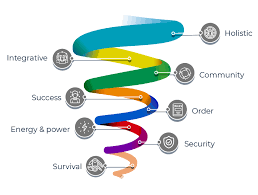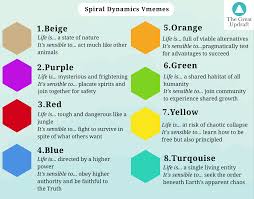



Overview
Spiral Dynamics is a powerful framework for understanding the evolution of human consciousness on both individual and societal levels. Originally developed by Clare W. Graves and later expanded by Don Beck and Christopher Cowan, Spiral Dynamics maps human values, worldviews, and problem-solving approaches across eight developmental stages, each represented by a distinct color.
Each stage reflects a unique way of engaging with the world—from survival instincts to communal belonging, from structured order to flexible integration. By identifying where we or others operate within this model, we can gain insight into decision-making, personal growth, leadership styles, and social transformation.
Understanding these levels of consciousness enables individuals to navigate internal shifts, external transitions, and relationships with greater awareness and adaptability.
Life Transitions Readings
Spiral Dynamics offers a lens for understanding how consciousness evolves through change. By recognizing which stage is dominant, individuals can make more aligned decisions during life transitions. Because consciousness development is cyclical rather than linear, individuals may revisit earlier stages under stress before reintegrating at higher levels of awareness.
Beige (Survival & Instinct): In times of crisis, individuals may regress to a focus on basic survival, requiring security and stability before moving forward.
Blue (Order & Stability): May resist uncertainty and require structure during periods of transition.
Orange (Achievement & Strategy): Likely to embrace change by setting new goals and pursuing success-driven solutions.
Yellow (Integrative & Systems Thinking): Approaches transitions with a broader perspective, seeing challenges as opportunities for holistic problem-solving.
By identifying your current Spiral Dynamics stage, a reading can provide practical strategies to help you adapt and grow with clarity, recognizing that movement through these stages is part of a fluid evolutionary process.
Baby and Child Readings
Spiral Dynamics also helps illuminate a child’s emerging consciousness, offering parents insight into their inner world and development. Children move through different Spiral stages as they develop, and understanding these phases allows parents to support their child's natural learning trajectory.
Purple (Tribal/Community): A child with strong Purple tendencies thrives in nurturing, tradition-oriented environments where a sense of belonging is central.
Red (Power/Independence): A child leaning toward Red may challenge authority and require balanced guidance to channel their energy productively.
Blue (Discipline & Structure): As children grow, they may develop a Blue orientation, seeking order, routines, and rules to create stability.
Orange (Curiosity & Achievement): Later in development, some children show increased Orange tendencies—setting goals, striving for independence, and valuing personal success.
Recognizing these patterns early allows parents to provide the best support for their child's unique development, fostering healthy learning environments and growth. Since Spiral Dynamics is not rigid, children may express multiple layers of consciousness at once, depending on context and upbringing.
Couples Synergy Readings
In relationships, understanding each partner’s dominant Spiral Dynamics stage helps clarify core values, communication styles, and potential areas of conflict or synergy. Because individuals move fluidly between stages, conflicts often arise when one partner operates from a different worldview than the other.
Strengths: A Yellow (Integrative) individual and a Green (Community-driven) partner may collaborate well, valuing harmony, deep discussions, and collective growth.
Challenges: A Blue (Traditional) partner and an Orange (Success-driven) partner may struggle with conflicting worldviews—one prioritizing rules and structure, while the other values progress and innovation.
Evolution in Relationships: A couple may initially share a common worldview (e.g., both in Orange), but as one shifts toward Green or Yellow, tensions may arise as priorities realign.
By mapping both partners’ Spiral Dynamics profiles, readings can provide guidance on growth, conflict resolution, and long-term relationship alignment. When partners recognize that they are not static but evolving, they can better navigate relational shifts with greater flexibility and understanding.